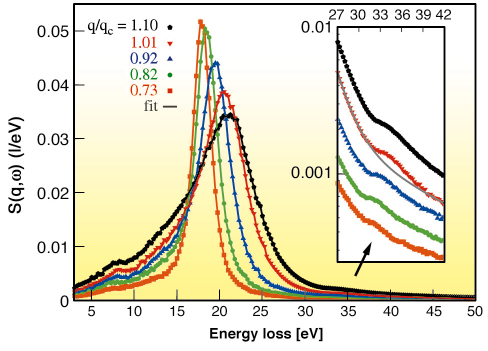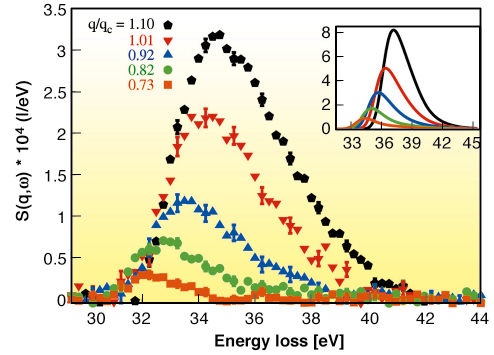- Home
- Users & Science
- Scientific Documentation
- ESRF Highlights
- ESRF Highlights 2005
- High Resolution and Resonance Scattering
- Intrinsic Double-plasmon Excitations in Simple Metals
Intrinsic Double-plasmon Excitations in Simple Metals
The plasmon is a unique and well understood collective excitation in the interacting electron gas. More than three decades ago the simultaneous excitation of two plasmons was predicted as a special correlation effect [1]. The quantitative theoretical treatment of this intrinsic plasmon-plasmon (pl-pl) excitation has to consider effects beyond the so-called random-phase approximation, which has explained the single-plasmon excitation reasonably well. Thus, a calculation of the intrinsic pl-pl excitation for arbitrary momentum transfer q and energy transfer w was accomplished only recently [2]. These calculations predict that this manifestation of a pure correlation effect becomes experimentally observable in the high energy-loss tail of the dynamic structure factor S(q,![]() ) of simple metals.
) of simple metals.
 |
|
Fig. 20: Measurements of the dynamic structure factor of aluminium for different momentum transfer. The inset highlights the intrinsic double-plasmon feature in the tail of the plasmon excitation. |
Inelastic X-ray scattering (IXS) is the favourable technique to study the high energy tail of the dynamic structure factor for large momentum transfers because multiple scattering does not affect the experimental spectra in contrast to electron energy loss spectroscopy, where extrinsic plasmon losses can obscure the information on electron correlations. IXS measurements of the dynamic structure factor were performed for aluminium single crystals and polycrystalline sodium at different momentum transfer around the plasmon cut-off vector qC at beamline ID16 utilising the Rowland-type spectrometer. The experimental results of aluminium for q || [100] are presented in Figure 20. The dominating feature in the spectra is the single-plasmon excitation around an energy loss of 20 eV. Nevertheless, in the high energy-loss tail a structure around 35 eV is visible which is highlighted in the inset of this figure. This structure is extracted from the slowly decreasing tail of the plasmon excitation and is presented in Figure 21. The theoretical pl-pl excitation spectra calculated using many-body perturbation theory of the homogeneous-electron-gas model beyond the random-phase approximation [2] are shown in the inset of Figure 21 for comparison. Based on the q-dependence of both the intensity and the peak position of this feature it could be unambiguously attributed to the predicted intrinsic pl-pl excitation when compared to theory. The experimental and computed pl-pl spectra exhibit also the same shape but the theory overestimates the energy-loss position of the pl-pl excitation by 2 eV which could be related to band structure and correlation effects beyond this theoretical approach. Moreover, the measurements for q || [100] and q || [110] on aluminium single crystals show no significant q-orientation dependence of the intrinsic double-plasmon feature even though the shape S(q,![]() ) is strongly q-orientation dependent. The pl-pl excitation was also measured in the high energy-loss tail of the dynamic structure factor of polycrystalline sodium and was found to be in good agreement with theory.
) is strongly q-orientation dependent. The pl-pl excitation was also measured in the high energy-loss tail of the dynamic structure factor of polycrystalline sodium and was found to be in good agreement with theory.
 |
|
Fig. 21: Extracted double-plasmon excitation spectra compared to theoretical predictions (inset). |
In conclusion, new structures in the high energy-loss tail of the dynamic structure factor of simple metals, aluminium and sodium, have been found and could be clearly attributed to intrinsic pl-pl excitations. These structures are a unique manifestation of electron correlation and are hardly influenced by lattice effects. Therefore, intrinsic double-plasmon excitations offer a new testing ground for the theoretical description of correlation effects for systems which closely resemble the jellium model by means of a diagrammatic expansion of the polarisability.
References
[1] M. Hasegawa and M. Watabe, J. Phys. Soc. Jpn. 27, 1393 (1969); D. F. DuBois and M. G. Kivelson, Phys. Rev. 186, 409 (1969).
[2] K. Sturm and A. Gusarov, Phys. Rev. B 62, 16474 (2000).
Principal Publication and Authors
C. Sternemann (a), S. Huotari (b), G. Vankó (b), M. Volmer (a), G. Monaco (b), A. Gusarov (c,d), H. Lustfeld (c), K. Sturm (c) and W. Schülke (a), Phys. Rev. Lett. 95, 157401 (2005).
(a) Department of Physics, University of Dortmund (Germany)
(b) ESRF
(c) Forschungszentrum Jülich GmbH (Germany)
(d) SCK.CEN (Belgium)



